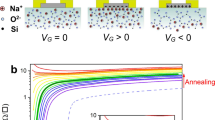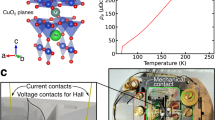Abstract
The critical temperatures of (Ln1−xMx)2CuO4 superconductors1, in which Ln3+ (La and other lanthanides) and M2+ (Ca, Sr, Ba) cations are randomly distributed amongst the ‘type A’ lattice sites, are known to depend on the doping level, x, and the mean A-site cation radius, 〈rA〉 (refs 2, 3). Here we show, by studying series of compositions with the same doping level and 〈rA〉, that the critical temperature decreases linearly with increasing A-site disorder, as quantified by the variance in the distribution of A-site cation radii. From this, we are able to show that, in the absence of disorder, the critical temperature should increase quadratically with 〈rA〉 for superconductors containing a single CuO2 layer. Our results therefore show that the critical temperature is very sensitive to lattice strains, as has also been shown for the metal to insulator transition temperature in the magnetoresistive (Ln1−xMx)MnO3 perovskites4.
This is a preview of subscription content, access via your institution
Access options
Subscribe to this journal
Receive 51 print issues and online access
$199.00 per year
only $3.90 per issue
Buy this article
- Purchase on Springer Link
- Instant access to full article PDF
Prices may be subject to local taxes which are calculated during checkout



Similar content being viewed by others
References
Bednorz, J. G. & Muller, K. A. Possible high-Tcsuperconductivity in the Ba-La-Cu-O system. Z. Phys. B 64, 189–193 (1986).
Torrance, J. B. et al. Properties that change as superconductivity disappears at high-doping concentrations in La2−xSrxCuO4. Phys. Rev. B 40, 8872–8877 (1989).
Tarascon, J. M., Greene, L. H., McKinnon, W. R. & Hull, G. W. Superconductivity in rare-earth doped oxygen-defect perovskites La2−x−yLnySrxCuO4−z. Solid State Commun. 63, 499–505 (1987).
Rodriguez-Martinez, L. M. & Attfield, J. P. Cation disorder and size effects in magnetoresistive manganese oxide perovskites. Phys. Rev. B 54, R15622–R15625 (1996).
Shannon, R. D. Revised effective ionic radii and systematic studies of interatomic distances in halides and chalcogenides. Acta Crystallogr. A 32, 751–767 (1976).
Tarascon, J. M., Green, L. H., McKinnon, W. R., Hull, G. W. & Geballe, T. H. Superconductivity at 40 K in the oxygen-defect perovskites La2−xSrxCuO4−y. Science 235, 1373–1376 (1987).
Oh-Ishi, K. & Syono, Y. Dependence of lattice parameters and Tcon the hole concentration determined by precise measurement of the oxygen content of MxLa2−xCuO4−y(M = Ba, Sr, Ca). J. Solid State Chem. 95, 136–144 (1991).
Büchner, B. et al. Low temperature phase transition and superconductivity in (LaNd)-Sr-Cu-O. Physica C 185–189;, 903–904 (1991).
Day, P. et al. Temperature dependence of the crystal structure of the ceramic superconductor La1.85Sr0.15CuO4: a powder neutron diffraction study. J. Phys. C: Solid State Phys. 20, L429–L434 (1987).
Dabrowski, B. et al. Suppression of superconducting transition temperature in orthorhombic La2−xCaxCuO4. Physica C 217, 455–460 (1993).
Dabrowski, B. et al. Dependence of superconducting transition-temperature on doping and structural distortion of the CuO2planes in La2−xMxCuO4(M = Nd, Ca, Sr). Phys. Rev. Lett. 76, 1348–1351 (1996).
Slater, P. R. et al. An improved route to the synthesis of superconducting copper oxyfluorides Sr2−xAxCuO2F2+δ(A = Ca, Ba) using transition metal difluorides as fluorinating reagents. Physica C 253, 16–22 (1995).
Huve, M. et al. A70 K superconductor, the oxycarbonate Tl0.5Pb0.5Sr4Cu2(CO3)O7. Physica C 205, 219–224 (1993).
Wagner, J. L. et al. Multiple defects in overdoped Tl2Ba2CuO6+δ: effects on structure and superconductivity. Physica C 277, 170–182 (1997).
Asab, A., Armstrong, A. R., Gameson, I. & Edwards, P. P. Single-step synthesis and crystal structure of HgBa2CuO4+δwith a Tcof 97 K. Physica C 255, 180–187 (1995).
Axe, J. D. & Crawford, M. K. Structural instabilities in lanthanum cuprate superconductors. J. Low Temp. Phys. 95, 271–284 (1994).
Rodriguez-Martinez, L. M. & Attfield, J. P. Cation disorder and the metal-insulator transition temperature in manganese oxide perovskites. Phys. Rev. B (in the press).
Bordet, P. et al. Structural instability around Tcobserved in Hg-1201 by neutron powder diffraction and EXAFS. Physica C 282, 1081–1082 (1997).
Acknowledgements
We thank H. Fuess for access to thermogravimetric equipment at Technische Universitat Darmstadt, and the British Council for an ARC grant.
Author information
Authors and Affiliations
Corresponding author
Rights and permissions
About this article
Cite this article
Attfield, J., Kharlanov, A. & McAllister, J. Cation effects in doped La2CuO4 superconductors. Nature 394, 157–159 (1998). https://doi.org/10.1038/28120
Received:
Accepted:
Published:
Issue Date:
DOI: https://doi.org/10.1038/28120
This article is cited by
-
Linear-in-temperature resistivity for optimally superconducting (Nd,Sr)NiO2
Nature (2023)
-
Pronounced interplay between intrinsic phase-coexistence and octahedral tilt magnitude in hole-doped lanthanum cuprates
Scientific Reports (2022)
-
Effect of Orthorhombicity on the Electronic Structure and Superconducting Properties of High-\(T_c\) Cuprate Family
Journal of Superconductivity and Novel Magnetism (2021)
-
Synthesis, structural and morphological characterizations of nano-Ru-based perovskites/RGO composites
Scientific Reports (2019)
-
Cooperative elastic fluctuations provide tuning of the metal–insulator transition
Nature (2019)
Comments
By submitting a comment you agree to abide by our Terms and Community Guidelines. If you find something abusive or that does not comply with our terms or guidelines please flag it as inappropriate.



